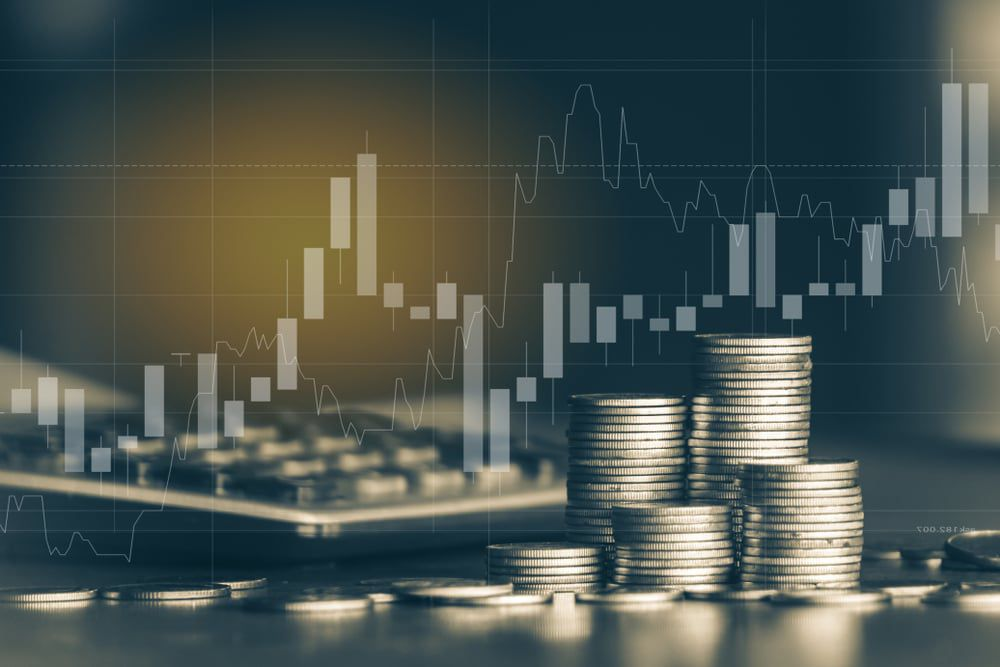Commodity Market Rollercoaster: Navigating the Ups and Downs of Futures Trading
Meta Description: Dive deep into the complex world of commodity futures trading. Explore the factors driving market fluctuations, understand the risks and rewards, and discover strategies for navigating this volatile landscape.
Imagine this: You're a seasoned investor trying to make sense of the daily ups and downs of the commodity market. One day, you're celebrating record-high prices for copper, the next, you're watching crude oil tumble. It's a wild ride, and it can be tough to stay ahead of the curve.
This is the reality for anyone who dabbles in commodity futures trading. It's a high-stakes game where timing is everything. But with the right knowledge and strategies, you can tilt the odds in your favor and potentially reap significant rewards.
This article is your guide to navigating the complexities of the commodity market. We'll delve into the key drivers of price fluctuations, explore the different types of commodities, and uncover strategies for managing risk and maximizing profits. Whether you're a seasoned trader or a curious beginner, this deep dive into the world of futures will equip you with the tools and insights you need to make informed decisions.
What Are Commodity Futures?
Commodity futures are contracts that obligate the buyer to purchase and the seller to sell a specific quantity of a commodity at a predetermined price and date in the future. Think of it as a pre-agreed deal, like a handshake, for exchanging something valuable at a later point in time. But instead of shaking hands, you're signing a contract.
Let's break down the key components:
- Commodity: This refers to a raw material or primary product, like oil, gold, wheat, or even livestock.
- Future: This signifies that the transaction is taking place at a future date, not immediately.
- Contract: This is the legal document that outlines the terms of the agreement, including the quantity, price, and delivery date.
Why are commodity futures so important? They allow businesses to hedge against price fluctuations and manage their risk. Imagine you're a baker who needs a consistent supply of wheat. You can use a futures contract to lock in the price of wheat today, ensuring you'll have it available at a future date, even if prices rise significantly.
Understanding the Forces that Shape Commodity Prices
Commodity prices are influenced by a complex interplay of factors. Think of it as a delicate balance scale, with different forces pushing the needle up or down. Here's a breakdown of the key drivers:
1. Supply and Demand: This is the most fundamental principle in any market. If demand for a commodity is higher than its supply, the price will likely rise. Conversely, if supply outpaces demand, the price will decline.
2. Economic Conditions: Global economic growth, interest rates, and inflation can all impact commodity prices. For instance, a strong economy often leads to increased demand for commodities, pushing prices higher.
3. Geopolitical Events: Political instability, wars, and natural disasters can disrupt supply chains and create price volatility. Think of the impact of a major oil-producing nation experiencing unrest.
4. Technological Advancements: New technologies can impact both supply and demand. For example, the development of shale oil extraction techniques has significantly increased oil production, leading to lower prices.
5. Speculation: Professional traders and investors actively buy and sell commodity contracts based on their predictions of future price movements. This speculation can amplify price swings.
Navigating the Risks and Rewards of Commodity Futures
Commodity futures trading is a high-reward, high-risk game. Let's explore the potential benefits and pitfalls:
Potential Rewards:
- Profit from Price Fluctuations: If you correctly predict the direction of price movements, you can profit from the difference between the contract price and the market price at the time of settlement.
- Hedge Against Price Risk: Commodity futures can help businesses manage price risks associated with their operations, like a baker using wheat futures to secure their supply.
- Diversify Investment Portfolio: Adding commodity futures to your investment portfolio can provide diversification and potentially reduce overall risk.
Potential Risks:
- High Volatility: Commodity prices can fluctuate significantly, leading to potentially substantial losses if your predictions are wrong.
- Liquidity Risks: Some commodity markets may lack liquidity, making it difficult to exit a position quickly at a desired price.
- Counterparty Risk: There's a risk that the other party to the contract may not be able to honor their obligations, leaving you with losses.
Strategies for Success in Commodity Futures Trading
Now that we've explored the risks and rewards, let's dive into some strategies for thriving in the volatile world of commodity futures:
1. Fundamental Analysis: This involves studying factors like supply and demand, economic conditions, and geopolitical events that influence commodity prices. This approach can help you identify potential opportunities and avoid potential pitfalls.
2. Technical Analysis: This focuses on analyzing historical price data to identify patterns and trends. By analyzing charts and using technical indicators, you can try to predict future price movements.
3. Trend Following: This strategy involves identifying and riding the momentum of an established price trend. If a commodity's price is consistently increasing or decreasing, you can try to capitalize on this trend.
4. Contrarian Trading: This involves taking a position opposite to the prevailing market sentiment. If everyone is bullish on a particular commodity, you might consider shorting it, betting on a price decline.
5. Diversification: Don't put all your eggs in one basket. Spreading your investments across different commodities and markets can help you manage risk and potentially enhance returns.
6. Risk Management: Never invest more than you can afford to lose. This is a crucial part of any investment strategy, but it's particularly important in the volatile world of commodity futures.
The Importance of Understanding Seed Keywords in Commodity Futures Trading
Seed Keywords: Your Compass in the Commodity Market
As a trader, your journey through the complex world of commodity futures begins with understanding the seed keywords. These words and phrases are the foundation of your research, your search engine optimization, and your overall understanding of the market.
Seed keywords are the building blocks of your trading strategy:
- They provide context. When you're researching a commodity like copper, knowing its key drivers like global economic growth, industrial production, and electric vehicle adoption helps you understand the underlying forces at play.
- They connect you to relevant information. By focusing on specific seed keywords like crude oil, OPEC, geopolitical risks, and demand outlook, you can find articles, reports, and data that directly relate to your research.
- They help you track market trends. Observing the frequency and prominence of seed keywords like gold, inflation, and safe haven can provide valuable insights into market sentiment.
Here's how you can leverage seed keywords effectively:
- Identify your target commodity: What are you interested in trading? Focus your efforts on the seed keywords related to that specific commodity.
- Research the key drivers: Understand the fundamental factors that influence the price of your target commodity. Use seed keywords related to supply and demand, economic conditions, geopolitical events, and technological advancements.
- Explore relevant news and data: Search for articles, reports, and data using seed keywords to stay informed about current market trends and developments.
- Optimize your trading strategy: Use seed keywords to refine your trading approach, focusing on technical indicators, trading strategies, and risk management techniques that are relevant to your chosen commodity.
- Stay informed about market sentiment: Monitor the frequency and prominence of seed keywords related to your commodity to gauge market optimism or pessimism.
By mastering the art of seed keyword utilization, you'll gain a competitive edge in the dynamic and ever-changing world of commodity futures trading.
Frequently Asked Questions
1. How do I get started in commodity futures trading?
- Research and Education: Start by educating yourself about the basics of futures trading, including different types of contracts, risk management techniques, and trading strategies.
- Choose a Broker: Select a reputable brokerage firm that offers access to commodity futures markets and provides the tools and resources you need.
- Start Small: Begin with a small amount of capital and gradually increase your investment as you gain experience and confidence.
2. What are some of the most popular commodities traded?
- Energy: Crude oil, natural gas, gasoline
- Metals: Gold, silver, copper, platinum
- Agriculture: Wheat, corn, soybeans, coffee
- Livestock: Cattle, hogs, pork bellies
3. What are the benefits of trading commodity futures?
- Potential for High Returns: Commodity prices can fluctuate significantly, offering the potential for substantial profits.
- Hedging Against Price Risk: Futures contracts can help businesses manage price risks associated with their operations.
- Diversification: Adding commodity futures to your investment portfolio can provide diversification and potentially reduce overall risk.
4. What are the risks of trading commodity futures?
- High Volatility: Commodity prices can move rapidly, potentially leading to significant losses.
- Liquidity Risks: Some commodity markets may lack liquidity, making it difficult to exit a position quickly at a desired price.
- Counterparty Risk: There's a risk that the other party to the contract may not be able to honor their obligations, leaving you with losses.
5. How do I manage risk in commodity futures trading?
- Use Stop-Loss Orders: Set a price point at which you'll automatically exit a position if the market moves against you.
- Diversify Your Portfolio: Spread your investments across different commodities and markets to reduce your exposure to any single risk.
- Don't Over-Leverage: Avoid using excessive leverage, as this can amplify your losses.
6. What are some resources for learning more about commodity futures trading?
- Online Courses and Educational Platforms: Many online platforms offer courses and resources on commodity futures trading.
- Books and Articles: A wide array of books and articles are available on the subject.
- Financial News Websites: Websites like Bloomberg, Reuters, and the Wall Street Journal provide news and analysis on commodity markets.
Conclusion
The world of commodity futures trading is a dynamic and complex landscape. It offers both immense potential rewards and significant risks. By understanding the key drivers of commodity prices, employing effective trading strategies, and managing risk diligently, you can position yourself for success in this high-stakes arena. Remember, knowledge is power. Educate yourself, stay informed, and approach the market with a plan and a disciplined mindset. The journey through commodity futures may be volatile, but with the right tools and knowledge, you can navigate it with confidence.



